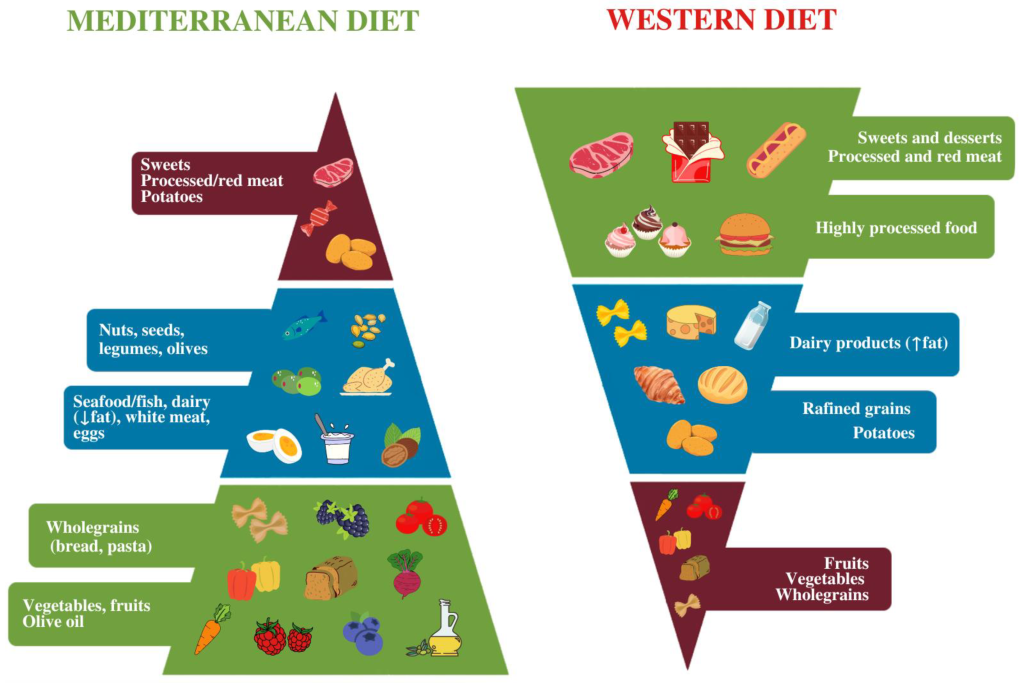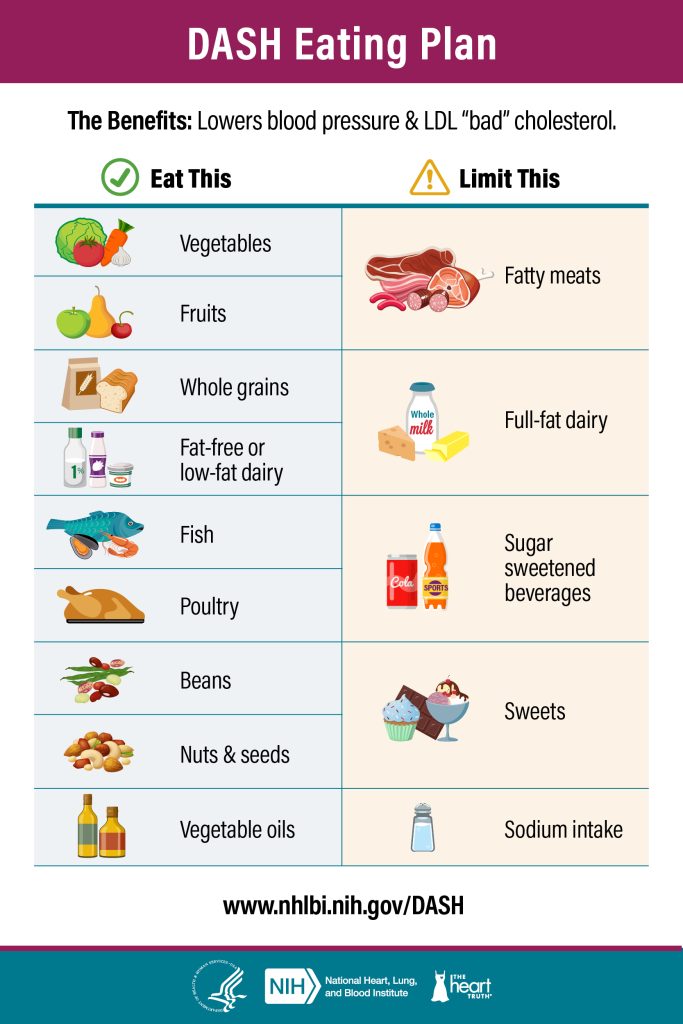3.4 Specific Dietary Recommendations Based on Health Conditions
Health care providers prescribe a variety of diets to prevent and treat a variety of health conditions. Nurses teach clients how to integrate these diets and healthy food choices into their lifestyles. The following subsections will summarize dietary recommendations for common chronic diseases.
Hypertension and Cardiovascular Disease
A person’s diet can be a significant risk factor in the development of hypertension and cardiovascular disease. Excessive consumption of processed foods, unhealthy trans fats, sugars, and sodium has been shown to increase the probability of developing hypertension and cardiovascular disorders. The American Heart Association encourages heart-healthy diets such as the Mediterranean diet, DASH diet, and diets with limited intake of processed foods, saturated fats, trans fats, sodium, added sugars, and alcohol.[1]
Saturated fats should be limited, but unsaturated and monounsaturated fats are considered healthy choices, such as those found in seafood, nuts, seeds, avocados, and healthy oils like olive, canola, corn, peanut, safflower, soybean, or sunflower oil. Additionally, oil-based salad dressings are healthier than cream-based, such as ranch dressing.[2]
Trans fats are unhealthy and found in margarines and some store-bought baked goods. Trans fats are created by hydrogenating oils, so they are solid at room temperature. Trans fats raise a person’s low-density lipoproteins (LDL) and lower the high-density lipoproteins (HDL), which both contribute to atherosclerosis, or clogging of arteries.[3]
The American Heart Association also recommends reducing meat intake to lower the risk of cardiovascular disease and obesity. Clients can use alternative protein sources of plant-based beans, legumes, nuts, seeds, and whole grains instead of meat. When selecting meat for purchase, lean meat without visible fat should be chosen.[4]
Mediterranean Diet
Several research studies support the effectiveness of the Mediterranean diet to promote health. The Mediterranean diet differs from MyPlate recommendations in that it limits red meat and emphasizes plant sources, poultry, and fish. It has been endorsed by the American Heart Association and others to prevent myocardial infarctions, cerebrovascular accidents, obesity, diabetes, hypercholesterolemia, and hypertension. According to the National Foundation for Cancer Research, it also helps decrease overall cancer mortality with a reduced risk of colorectal, breast, stomach, pancreatic, prostate, and lung cancers.[5]
Named for diets commonly consumed by people living in countries bordering the Mediterranean Sea, the Mediterranean diet features fresh fruits, vegetables, grains, beans, legumes, low-fat or fat-free dairy, fish, poultry, and nuts. Olive oil is commonly used in the Mediterranean diet. The diet also limits added sugars, sodium, highly processed foods, refined carbohydrates, saturated fats, and fatty or processed meats.[6] See Figure 3.8[7] for an illustration comparing the Mediterranean diet containing a high intake of high fiber, natural foods to that of a typical Western diet with a high intake of processed, low-fiber foods.

DASH Diet
The Dietary Approaches to Stop Hypertension (DASH) diet focuses on limiting saturated and trans fats and sodium while consuming foods rich in potassium, calcium, magnesium, fiber, and protein. In combination with other heart-healthy lifestyle changes, such as increased physical activity and maintaining a healthy weight, these dietary changes can have a significant impact on cardiovascular health and the risk for hypertension.[8] See Figure 3.9[9] for an illustration of the DASH diet.

Diabetes
People with diabetes may manage their diets in a variety of ways. One method is carbohydrate counting (called carb counting) where a client administers insulin based on their carbohydrate intake. For example, a client may have daily allotted carbohydrates of 60 grams of carbs per meal and 15 grams of carbs per snack. This advanced form of carb counting is recommended for people on intensive insulin therapy by injections or pump. Clients often work with a diabetic educator or dietician to understand their prescription for carb counting, and many use charts or apps that calculate how many carbohydrate grams are in a specific food choice.[10]
A second method to manage a diet for a diabetic is called carbohydrate choices. In this method, one “carbohydrate choice” refers to a food choice with 15 grams of carbs. For example, a small apple has 15 grams of carbs. Clients are prescribed how many carb choices they may select per meal or snack. The US Department of Agriculture’s Food Data Central is a searchable database that can be used to explore the nutrition content of food, including carbs.[11]
View the US Department of Agriculture’s Food Data Central database at https://fdc.nal.usda.gov/.
A third method recommended by the American Diabetes Association to manage blood glucose levels is by using modified USDA MyPlate dietary guidelines. (See Figure 3.6 in the “Dietary Recommendations According to Age and Developmental Level” section for MyPlate dietary guidelines.) When using this method, the client plans a meal in which half of their plate is filled with non-starchy vegetables such as broccoli, carrots, cabbage, or leafy greens. The remainder of the plate is split equally between lean protein foods and carbohydrate foods (such as brown rice or sweet potatoes).[12]
Chronic Kidney Disease
Clients with chronic kidney disease (CKD) have impaired filtration, resulting in a buildup of waste products in the blood. Diets are typically prescribed that limit intake of sodium, potassium, and phosphorus to help prevent the buildup of these minerals in the blood. Additionally, protein intake may also be limited because the kidneys remove the waste products from the breakdown of protein. Clients with CKD are often referred to a dietician who can assist them in developing an eating plan to delay the progression of disease, minimize complications, and improve their quality of life.[13],[14]
Cancer
Although no one food can prevent cancer, a diet filled with fruits, vegetables, whole grains, beans and legumes, and other plant foods can lower the risk for many cancers. On the other hand, other foods contribute to the development of cancer, such as alcohol; red meat; processed meat such as sausages, ham, salami, and hot dogs; and sugar-sweetened drinks.[15]
People with cancer have unique dietary needs, such as getting enough food intake and calories while also dealing with symptoms like nausea, constipation, and diarrhea. Cancer treatments typically kill fast-growing cells, such as those in the digestive tract, contributing to the development of mouth sores that further impact intake. During treatment, clients require protein and calories and should be encouraged to eat when they feel the best. They should eat what is well-tolerated without being concerned about incorporating a variety of foods. Additionally, clients should drink 8-12 cups of liquid per day, even on the days they find eating food difficult, in order to stay hydrated.[16]
Clients undergoing chemotherapy treatment typically have low white blood cell counts that put them at high risk for food-borne illness. Nurses encourage clients to follow standard food safety guidelines, plus additional considerations based on their condition, including the following[17]:
- Minimize microbial growth by keeping hot foods hot and cold foods cold.
- Place leftover food in the refrigerator right after eating.
- Scrub fruits and vegetables before eating.
- Wash food preparation surfaces and utensils.
- Use separate utensils and cutting boards for raw meat and other food.
- Thaw meat in the refrigerator or defrost in the microwave.
- Cook foods to recommended temperatures.[18]
- Cook eggs until yolks are hard, not runny.
- Use pasteurized dairy products.
- Do not eat food that has been at room temperature longer than two hours.
Bone Health and Osteoporosis
Maternal nutrition influences bone growth in the fetus, so nurses should encourage sufficient calcium and vitamin D intake during pregnancy. Adequate intake of calcium and vitamin D intake is necessary for children and adolescents because bones continue to grow through their mid-twenties. In adults, sufficient calcium and vitamin D can reduce the risk of developing osteoporosis.[19]
- Casas, R., Castro-Barquero, S., Estruch R., & Sacanella, E. (2018). Nutrition and cardiovascular health. International Journal of Molecular Sciences, 19(12), 3988. https://doi.org/10.3390/ijms19123988 ↵
- Office of Disease Prevention and Health Promotion. (2023). Heart-healthy foods: Shopping list. https://health.gov/myhealthfinder/health-conditions/heart-health/heart-healthy-foods-shopping-list ↵
- Ophardt, C., & Rodriguez, A. (2022). Hydrogenation of unsaturated fats and trans fat. Chemistry LibreTexts. https://chem.libretexts.org/Bookshelves/Biological_Chemistry/Supplemental_Modules_(Biological_Chemistry)/Lipids/Fatty_Acids/Hydrogenation_of_Unsaturated_Fats_and_Trans_Fat ↵
- American Heart Association. (2023). Vegetarian, vegan, and meatless meals. https://www.heart.org/en/healthy-living/healthy-eating/eat-smart/nutrition-basics/vegetarian-vegan-and-meals-without-meat ↵
- Ciupka, B. (2022). Does the Mediterranean diet prevent cancer? National Foundation for Cancer Research. https://www.nfcr.org/blog/does-the-mediterranean-diet-prevent-cancer/ ↵
- American Heart Association. (2024). What is the Mediterranean diet? https://www.heart.org/en/healthy-living/healthy-eating/eat-smart/nutrition-basics/mediterranean-diet ↵
- “nutrients-14-04390-g001” by Zielińska, M., Łuszczki, E., Michońska, I., & Dereń, K, is licensed by CC BY 4.0. Access for free at https://www.mdpi.com/2072-6643/14/20/4390 ↵
- National Heart, Lung, and Blood Institute. (2021). DASH eating plan. National Institutes of Health. https://www.nhlbi.nih.gov/education/dash-eating-plan ↵
- “DASH Easting Plan Pinterest_V3.jpg” by unknown author at the National Heart, Lung, and Blood Institute is in the Public Domain. Access for free at https://www.nhlbi.nih.gov/education/dash-eating-plan. ↵
- American Diabetes Association. (n.d.). Carb counting and diabetes. https://diabetes.org/food-nutrition/understanding-carbs/carb-counting-and-diabetes ↵
- U.S. Department of Agriculture. (2024). FoodData Central. Agricultural Research Service. https://fdc.nal.usda.gov/ ↵
- American Diabetes Association. (2020). What is the diabetes plate method? https://www.diabetesfoodhub.org/articles/what-is-the-diabetes-plate-method.html ↵
- National Institute of Diabetes and Digestive and Kidney Diseases. (2022). Diet & nutrition for adults with advanced chronic kidney disease. https://www.niddk.nih.gov/health-information/kidney-disease/chronic-kidney-disease-ckd/eating-nutrition/nutrition-advanced-chronic-kidney-disease-adults ↵
- National Institute of Diabetes and Digestive and Kidney Diseases. (2016). Eating right for chronic kidney disease. https://www.niddk.nih.gov/health-information/kidney-disease/chronic-kidney-disease-ckd/eating-nutrition ↵
- American Institute for Cancer Research. (n.d.). Foods that fight cancer. https://www.aicr.org/cancer-prevention/food-facts/ ↵
- National Cancer Institute. (2022). Eating hints: Before, during, and after cancer treatment. [PDF]. https://www.cancer.gov/publications/patient-education/eatinghints.pdf ↵
- National Cancer Institute. (2022). Eating hints: Before, during, and after cancer treatment. [PDF]. https://www.cancer.gov/publications/patient-education/eatinghints.pdf ↵
- FoodSafety.gov. (2024). Cook to a safe minimum internal temperature. https://www.foodsafety.gov/food-safety-charts/safe-minimum-internal-temperatures ↵
- International Osteoporosis Foundation. (n.d.). Maternal nutrition. https://www.osteoporosis.foundation/health-professionals/prevention/nutrition/maternal-nutrition ↵
A client administers insulin based on their carbohydrate intake.
A carbohydrate choice is a portion of food that contains 15 grams of carbohydrates.

